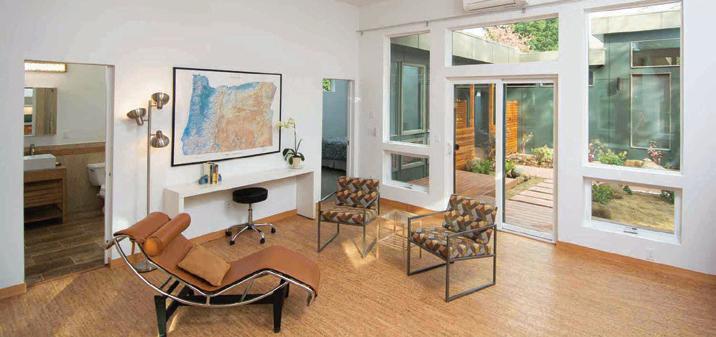
5 minute read
CONNECT
COMMUNITY RESOURCES & OUTREACH
BIG IDEAS
Hannah Bruegmann, Program Director of New Initiatives for Build It Green, shares what the organization does, how it does it and how rental housing providers can join in its mission to revitalize individuals, communities and bioregions.
What are Build It Green’s top priorities, and how have they evolved since the organization was founded in the early 2000s? Build It Green was founded to bring green practices into the mainstream residential building ecosystem through credible and accessible resources and training programs such as our GreenPoint Rated certification program. Our priorities still include encouraging more sustainable residential building practices. In addition to that foundation, we’ve realized that truly tackling the housing and climate crises will require focusing on not just individual homes, but also the larger neighborhood and community, including the local bioregion. To do that, we’re exploring how to bring a regenerative thinking approach to communities and the residential building sector. We’re starting by encouraging ADUs and the emerging ecosystem supporting them.
What is regenerative development? Regenerative development can be thought of as an approach that considers not only how to make the built ecosystem more sustainable, but also considers how we might use projects to improve the capacity of what are termed “whole” systems that nest in one another. We are thinking about building positive feedback loops where the capacity (skills, abilities, knowledge) of individuals in a community, the community as a whole (to create more opportunities and improvements), and the local environment (often termed “bioregion” for this purpose) can self-generate over time. This might look like a project that includes training local homeowners in how to maintain and improve their own properties, then leads to a group of them coming togeth-
er to create new projects that benefit the community and the place where they live in a totally new and previously unimagined way. This could then continue to thrive and grow, even if a few key community members leave.

You launched a pilot program in 2020 to dig into those ideas and how ADUs fit in. What was your approach, and what have you learned? Our original intent was to create an exploratory and educational program to map the actors and activities in the ADU space, and determine where the gaps might be that we can help fill, through building a network of diverse stakeholders. It was also to provide an entry-point to learning and understanding regenerative development ourselves.
We’ve learned there is lots of opportunity and potential in the ADU space, and it’s creating an emerging, specialized market of builders, companies and service providers, but there [is] also still a lot of progress to be made. While there are state level mandates, local jurisdictions are responsible for implementing and enforcing the rules, which can be inconsistent. We’re working with the Casita Coalition, among others, to help gather best practices for jurisdictions to create good ADU policy. We’re also working to gather best practices for builders, as the small spaces of ADUs pose some unique challenges— and opportunities!
How can rental housing providers in Alameda and Contra Costa counties be part of the solution to many of the challenges facing the East Bay housing ecosystem, while at the same time protecting their economic interests? ADUs offer an incredible opportunity
A stylish ADU interior
for single- and multifamily homeowners to be part of the housing solution. .... There is hope that the kinds of infill development ADUs offer will allow for more rental units where we need them—in thriving neighborhoods near transit and other existing services. UCLA’s Center for Regional Policy Studies estimated there’s market potential for up to 1.5 million new homes in California over the next five years through the construction of ADUs and JADUs. There’s a lot more to learn, but the potential is huge. ...
There are also educational resources to help homeowners be better informed about both the build process and becoming first-time [rental housing providers]. Both the County of San Mateo’s Second Unit Center and the Napa Sonoma ADU Center’s websites offer a calculator and other tools to plan for an ADU, and the California Department of Housing and Community Development (HCD) has a tenant/ landlord responsibilities resource to help learn best practices and regulations protecting both [renters and owners]. There are no East Bay-specific calculators yet, but lots of new resources are coming down the road.
Why is it valuable to bring diverse stakeholders together for conversations around these issues? It is incredibly important to bring together diverse perspectives because, as we learn in regenerative development, everything is interconnected when you take a living systems approach. Like the organs in our body—if, say, a lung stops performing optimally, it affects the performance of the whole body. The same goes for when something in the built environment, for example, is not aligned or as developed as the rest of the system. For ADUs, we have builders and building materials, but if there aren’t financing products readily available or the policy requirements aren’t easily understood, it’s going to slow down housing production. Diverse stakeholders help us recognize what is needed, what’s working and what’s not working in the system, and we can work together to realize a more beneficial and productive outcome for everyone.
Most people want to leave this world better than how they find it, and want to make a positive difference. We each have a role to play within the residential built environment to fully realize that vision. Build It Green’s goal to increase the well-being of occupants, communities and bioregions is a unifying concept that many can get behind. We hope you join us!
Visit builditgreen.org to learn more about Build It Green’s new initiatives as well as resources and programs useful to housing providers, such as its GreenPoint Rated checklist, Certified Professional Directory and webinars. Also, don’t miss our stories about green upgrades and prefab ADUs, beginning on p. 22 .







